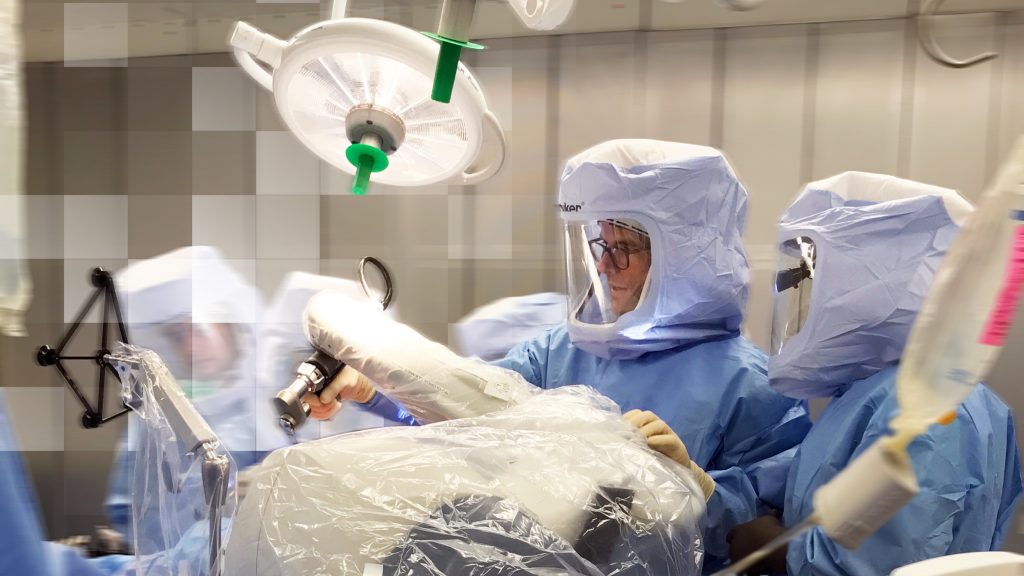
What are computer-assisted and robot-assisted joint replacement surgeries?
Computer-assisted surgery (CAS) and robot-assisted surgery are general terms representing a collection of “enabling technologies” for joint replacement surgery. Broadly, these technologies can be divided into the following categories:
- Robotic-assisted surgery
- Imageless surgical navigation
- Image-guided surgical navigation
- Sensor-guided surgery
- Patient-specific instrumentation
Why are these enabling technologies used for joint replacement?
During hip or knee replacement surgery, correct positioning of the implanted joint and appropriate soft tissue tensioning and balancing are critical to the short-term and long-term success of the joint replacement.
Enabling technologies allow the surgeon to achieve more precise component positioning and joint stability during the following procedures:
Do these technologies perform the surgery for the surgeon?
The short answer is no. Dr. McLawhorn uses these technologies to improve the accuracy of surgery, but he very much remains in control of your entire procedure. None of these devices are able to perform a surgery without direct surgeon control.
The soft tissue dissection and closure are performed by hand. Enabling technologies are used to guide reshaping and cutting the bone and implanting the prosthetic components. Sensor-guided technologies provide precise feedback to Dr. McLawhorn about the soft tissues around the operated joint, allowing him to selectively tighten or loosening ligaments and tendons to improve joint function and stability.
What are the advantages of computer-assisted joint replacement surgery?
There are many potential advantages to using computer-assisted technology during joint replacement surgery, including:
- Higher level of accuracy positioning new joint
- Less likely to have joint mal-alignment
- Improved soft tissue balance and joint stability
- Less likely limb length differences
- Potentially reduced risk for dislocation
- Lower implant wear possibly
- Lower risk for failed surgery and need for revision surgery potentially
- Improved patient satisfaction
While many advanced technologies are designated “investigational” or “experimental”, Dr. McLawhorn believes that the devices he uses represent value to his patients and their outcomes. Many studies, including several performed by Dr. McLawhorn, have supported improved implant alignment and positioning when the implants are placed with robotics or navigation. Recent studies from HSS have suggested that robotics lowers the risk for postoperative hip dislocation after total hip replacement, and there may be less risk of manipulation under anesthesia for knee stiffness after total knee replacement.
If you are suffering from severe joint pain and think you may need computer-assisted or robotic joint replacement surgery, it is important to seek advice from an orthopedic specialist to accurately diagnose and treat your joint pain. Dr. McLawhorn is a hip and knee specialist at Hospital for Special Surgery serving patients in New York City, and Stamford, Connecticut. To learn more, call 203-705-2113 (CT) / 212-606-1065 (NYC) today or schedule an appointment by using the form on this page.
FAQ
Who Is the Ideal Candidate for Computer-Assisted Hip Surgery?
The candidate requirements for computer-assisted hip surgery are the same as the traditional surgery. If you have recurring hip pain that has started to impact your daily life, you are eligible for computer-assisted hip surgery. There are also specific conditions that may require computer-assisted hip surgery to effectively treat them.
Below is a list of the conditions that can be treated with computer-assisted hip surgery:
- There is a tumor located within the hip joint.
- You are suffering from osteoarthritis.
- Your hip has rheumatoid arthritis.
- You had an injury, such as a hip fracture.
- Your hip has osteonecrosis, which is when there is a lack or permanent loss of blood.
Dr. Alexander McLawhorn will assess your needs and current medical conditions during your consultation with him. From there, he will determine the best approach to your hip-related ailments.
What Are the Benefits of Computer-Assisted Hip Surgery?
Although the operation is no different from traditional hip surgery, computer-assisted hip surgery does come with extra benefits for both you and the surgeon. This is because the computer guides the surgeon through the operation by providing clear images of the replacement components and where they are supposed to go.
It allows the surgeon to be more accurate, which can significantly reduce the risk of complications and failure.
Here is a list of other benefits that you can enjoy with computer-assisted hip surgery:
- You have a reduced chance of infection.
- You may have less scarring.
- You can recover a lot faster.
- Hip implants can have a longer life expectancy.
- Blood loss can be reduced.
Bear in mind that you may not experience all of these benefits, such as the reduced scarring.
Is the Recovery Different From Traditional Hip Surgery?
The recovery process for computer-assisted hip surgery is nearly identical to the traditional method. In most cases of traditional hip surgery, patients can usually start walking on their own after two to eight weeks. Those who get computer-assisted hip surgery can see a full recovery within two to six weeks.
How long it ultimately takes, however, does depend on your age and the current condition of your health.


